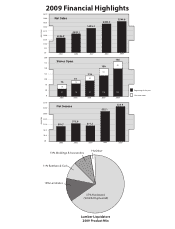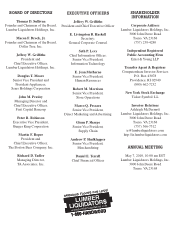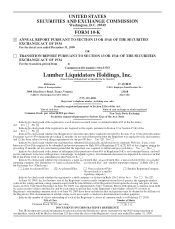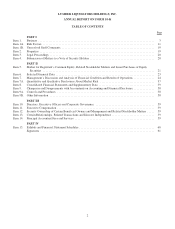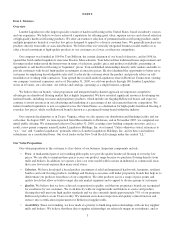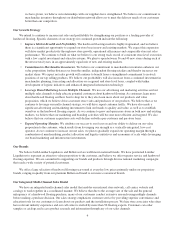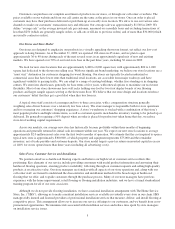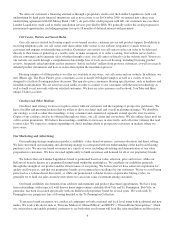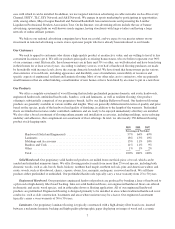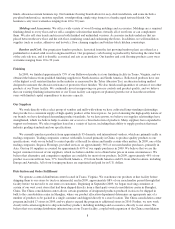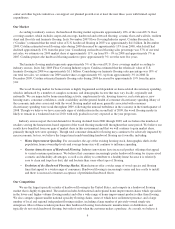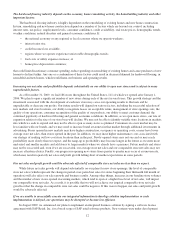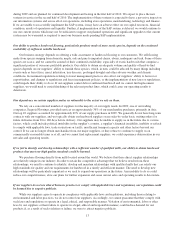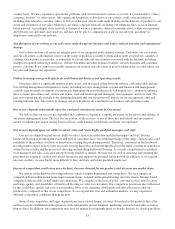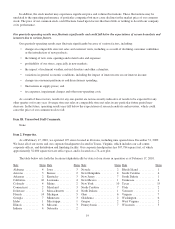Lumber Liquidators 2009 Annual Report Download - page 15
Download and view the complete annual report
Please find page 15 of the 2009 Lumber Liquidators annual report below. You can navigate through the pages in the report by either clicking on the pages listed below, or by using the keyword search tool below to find specific information within the annual report.center and other logistic initiatives, can support our planned growth over at least the next three years with limited capital
expenditures.
Our Market
According to industry sources, the hardwood flooring market represents approximately 10% of the overall U.S. floor
coverings market, which includes carpet and area rugs, hardwood and softwood flooring, ceramic floor and wall tile, resilient
sheet and floor tile and laminate flooring. In its November 2007 Floor Covering Industry report, Catalina Research, Inc.
(“Catalina”) estimated that the retail value of U.S. hardwood flooring in 2007 was approximately $4.1 billion. In December
2009, Catalina estimated wood flooring sales during 2009 decreased by approximately 15% from 2008, which itself had
declined approximately 13% from the prior year. Considering our hardwood flooring sales percentage was 57% of our total
net sales, we estimate our 2009 market share at approximately 11%, up from 8% - 9% in 2008 and approximately 7% in
2007. Catalina projects the hardwood flooring market to grow approximately 3% over the next five years.
The laminate flooring market represents approximately 5% of the overall U.S. floor coverings market according to
industry sources. In its July 2009 Floor Covering Industry report, Catalina estimated that the wholesale value of U.S.
laminate flooring in 2008 was approximately $1.1 billion. Considering our laminate flooring sales percentage was 18% of
our total net sales, we estimate our 2009 market share at approximately 6%, up from approximately 3% in 2008. In
December 2009, Catalina estimated laminate flooring sales during 2009 decreased by approximately 19% from the prior
year.
The wood flooring market for homeowners is highly fragmented and dependent on home-related discretionary spending,
which is influenced by a number of complex economic and demographic factors that may vary locally, regionally and
nationally. We are impacted by home remodeling activity, employment levels, housing turnover, real estate prices, new
housing starts, consumer confidence, credit availability and the general health of consumer discretionary spending. Many of
the economic indicators associated with the wood flooring market and more generally associated with consumer
discretionary spending were weak throughout 2009, following the unusual turbulence in the economy in the fourth quarter of
2008. Though we believe we have seen early signs of stabilization in the second half of 2009, the wood flooring market is
likely to remain in a weakened state in 2010, with only gradual recovery expected as the year progresses.
Industry sources report the total demand for flooring declined from 2006 through 2009, and we believe the number of
retailers serving the homeowner-based segment of the wood flooring market fell throughout that same period. We believe our
results have benefited from our gain of market share in this environment and that we will continue to gain market share,
primarily through new store openings. Though total consumer demand for flooring may continue to be adversely impacted by
macroeconomic factors, we believe the longer term trends benefiting hardwood flooring are favorable, including:
•Home Improvement Spending. For our market, the age of the existing housing stock, demographic shifts in the
population, home ownership levels and average home size will continue to influence spending.
•Greater Attractiveness of Hardwood Flooring. Industry innovations have increased product offerings that appeal
to varied consumer preferences. We believe that consumers increasingly prefer hardwood flooring for its perceived
cosmetic and durability advantages, as well as its ability to contribute to a healthy home because it is relatively
easy to clean and traps less dust, dirt and bacteria than some other types of flooring.
•Evolution of the Hardwood Flooring Market. Manufacturers offer a wider range of wood species and flooring
lines that appeal to a wider range of consumers. Hardwood flooring is increasingly easier and less costly to install
and there is increased consumer acceptance of prefinished hardwood floors.
Our Competition
We are the largest specialty retailer of hardwood flooring in the United States, and compete in a hardwood flooring
market that is highly fragmented. The market includes both national and regional home improvement chains which specialize
in the lower-end, higher-volume flooring market and offer a wide range of home improvement products other than flooring.
We also compete against smaller national specialty flooring chains, some of which have an Internet presence, and a large
number of local and regional independent flooring retailers, including a large number of privately-owned single-site
enterprises. Most of these retailers purchase their hardwood flooring from domestic manufacturers or distributors, and
typically do not stock hardwood flooring, but order it only when the customer makes a purchase. As a result, we believe it
9


